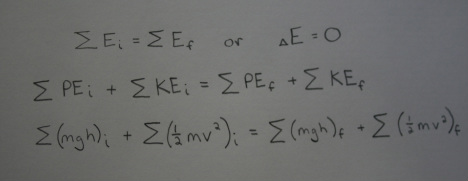Physics

http://fc09.deviantart.net/fs71/i/2010/113/6/3
Now let’s begin a discussion of the physics that control the
behavior of Newton’s Balls. We will consider two fundamental laws of physics:
the law of conservation of momentum and the law of conservation of energy of a closed
system. Both are similar in that they state that the total substance (in this
case momentum and energy) before a reaction is equal to the total substance at
the end in an isolated system. For Newton’s Cradle, the reaction is normally
the collision of the metal balls. Here are the laws in a simple form with the
components of each explicitly shown:
Conservation of momentum
Momentum is defined as the mass (m) of an object multiplied by the velocity (v). The summation signs merely state that the total initial momentum is equal to that of the final momentum in our system if no net forces act upon the body. This may be slightly confusing but think of an automobile starting from rest and then accelerating. Initially, there is no momentum, but the force exerted by the engine gave it momentum. This equation will work to our advantage when calculating velocities after a collision.
Conservation of energy
This is a break down, starting from the law statement to the individual components. Energy for our system is separated into two types of energy: Potential Energy and Kinetic Energy. Potential Energy is further broken down to the mass (m) multiplied by the acceleration due to gravity (g) and then multiplied by the vertical height (h) that the object is from a datum that we get to set. The Kinetic Energy is broken down into the constant (1/2) multiplied by the mass and then multiplied by the velocity (v) squared. When you put all this together, it simply states that all the initial energy is equal to all the final energy. In our case, energy takes two forms: potential energy (PE) and kinetic energy (KE).

